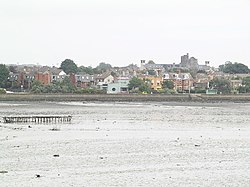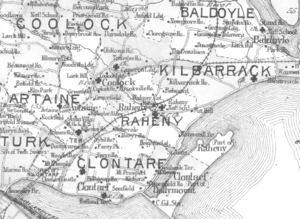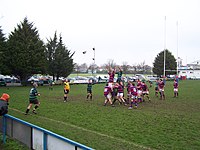Clontarf
| Clontarf Irish: Cluain Tarbh | |
| County Dublin | |
|---|---|
 Clontarf promenade | |
| Location | |
| Grid reference: | O194364 |
| Location: | 53°21’53"N, 6°12’25"W |
| Data | |
| Population: | 32,815 (2016) |
| Post town: | Dublin |
| Postcode: | 3 |
| Local Government | |
| Council: | Dublin |
Clontarf is a village of County Dublin, famous for a moment in history, which has become in the course of the ages a seaside suburb of the City of Dublin, and one of its more affluent suburbs, certainly for the city's Northside.[1] It is found on the north shore of Dublin Bay, east of the city centre.
The name of the village is from the Irish Cluain Tarbh, meaning "Meadow of the bull".
While Clontarf lacks a single "village centre", historically there were two centres of population; one on the coast towards the city, and the fishing village of Clontarf Sheds, farther north on the coast at what is now Vernon Avenue. Clontarf has a range of commercial facilities in several locations, mainly centred on Vernon Avenue. It adjoins the suburbs of Fairview, Marino, Killester, Artane and Raheny. The strict boundary between Dublin and Clontarf is the River Tolka, though this is now overspread with Dublin's own growth and the distinctness of Clontarf grows further east.
Clontarf is most famous for the Battle of Clontarf fought in 1014, in which Brian Boru, the usurping High King of Ireland, defeated the Norse of the Kingdom of Dublin and their allies, the Irish of Leinster. Though Brian was slain at the end of the battle and the Danes were restored to the city, the battle, which extended over a wide area, is seen as marking an end to the Irish-Viking Wars: never again would the Norse attempt to dominate Ireland outside their own colonies.
Clontarf is also a parish in the Barony of Coolock.[2]
Contents
Geography
Clontarf is on the northern side of Dublin city, north-east of the city centre, along the coast. It is bounded to the west and south by Fairview Park and the suburb of Marino, to the north by the suburbs of Killester, Artane and Coolock and to the northeast by Saint Anne's Park and the suburb of Raheny. The southern boundary of Clontarf lies on one side of the estuary of one of Dublin's three main rivers, the River Tolka. The Wad River, another of Dublin's secondary watercourses, joins the Tolka estuary right at the city end of Clontarf's coastline, while the Naniken River runs through St Anne's Park and reaches the sea at the Raheny end of the district, its mouth marking the parish boundary between Clontarf and Raheny. The district is fairly level, rising slightly inland.
Bull Island , sometimes 'North Bull Island' to distinguish it from the sandbank of the South Bull, also shared with Raheny, is connected to Clontarf at its northern end by an historic wooden bridge at Dollymount. While most of the island is city property, the (North) Bull Wall and breakwater, related road and path, and Bull (Wooden) Bridge belong to the Dublin Port Company, and are closed for a day each year to assert this. At the end of the breakwater is a statue of Our Lady, Star of the Sea, erected to watch over mariners and dockworkers.
Clontarf Island
There used to be an island, called Clontarf Island, off the coast of Clontarf near the mouth of the Tolka, as shown on maps such as that of John Rocque in 1753,[3] with a single dwelling, and at some periods (notably in the 19th century), bathing facilities. The island was also used as a refuge from plague in 1650. Construction work on the Great South Wall and Bull Wall in Dublin Port changed the flow of water in Dublin Bay, threatening its existence, though it was in fact eventually destroyed by a large storm in 1844.
History
Following the defeat of the Norse and the Leinstermen at the Battle of Clontarf in 1014, the High King of Ireland Brian Boru (Brian Boroimhe) is said to have been killed with a battle axe while he was found in prayer in his tent, by a Danish Viking named Brodu. So great was the fighting which ensured among competing kings afterwards that event that one analyst stated they, '...turned the country into a trembling sod.'
Clontarf itself enjoyed relative peace for over 100 years until the arrival of the Normans in 1172. Shortly afterwards, Clontarf was granted to Adam de Pheypo, a follower of Strongbow (Richard de Clare). Adam built the first Clontarf Castle.
A settlement at Clontarf has been dated to at least the 12th century, and in the 19th century remains from earlier times were thought to have been found. Clontarf features on the 1598 map "A Modern Depiction of Ireland, One of the British Isles" by Abraham Ortelius as "Clantarfe".
The manor and church of Clontarf were held by the Knights Templar and subsequently, after the Templars' dissolution, by the Hospitallers. There was a 'Holy Well' in the area, near what is now The Stiles Road, until recent times (another spring, named for Brian Boroimhe, of uncertain age, still exists, on Castle Avenue near the sea).
A manor house and small associated village was located on the slight ridge overlooking the sea where the Clontarf Castle Hotel is now situated. The manor house was rebuilt many times, with the current hotel dating largely to the early 19th century. The tower house on the site is a 19th-century replica of the original Templar structure on the site. The adjoining ruined church is the old Church of Ireland parish church, dates to the mid-17th century and includes what may be the earliest use of red brick in Ireland.
Clontarf Castle was burned in 1641 by Charles Coote, Cromwell's General, apparently in revenge for the 'disloyalty' of the then owner, George King. The castle, estate and district are then said to have been given by Cromwell to John Blackwell, who assigned his interest to John Vernon, Quartermaster-General of Cromwell's army in Ireland, although this is described in Lewis's Topographical Dictionary of 1837 as “conferred by the Crown on Admiral Vernon”. The Vernon family subsequently occupied the Castle for nearly three hundred and fifty years.
In 1659, the population of Clontarf was 79.
Fishing, oyster-catching and farming remained the main occupations over the following centuries, with a major fish-curing industry at the Sheds, near the foot of Vernon Avenue (the Public House at the site still bears the name), around 1 km from the original village. In the 18th century, this developed into a secondary settlement, of fishermen and small farmers, living in basic cabins and with drying sheds for the fish. It is prominently marked on navigation maps for Dublin Bay dating to the 18th century. However, as with many such 'informal' settlements in Ireland, Clontarf Sheds became the site for a 19th-century Roman Catholic church - the Church of Ireland St. John's Church, and the Roman Catholic St. Anthony's are closer to the original settlement - and then outgrew the original village.
The 1837 Lewis report remarked that “The land in this Parish is reported to be in the very highest state of cultivation...”
The 19th century
In the early 19th century, Clontarf had become a popular seaside resort for the citizens of Dublin, who came out from the city to enjoy bathing in the sea or in the hot and cold seawater baths erected by Mr. Brierly. A horse omnibus service from the city was started and Clontarf became a fashionable place to live - Samuel Lewis lists twenty-seven major houses, apart from Clontarf Castle, in which resided wealthy and important gentry. The Confirmation list for 1824 includes four titled ladies – Lady Charlemont, Lady Caroline Clements, Lady Maria Caulfield and Lady Emily Caulfield.
Clontarf had an important role in the career of the prominent Irish nationalist leader Daniel O'Connell who sought to hold on this location, symbolic because of its association with the Battle of Clontarf in 1014, a mass meeting calling for repeal of the Act of Union. The meeting was banned by then-Prime Minister, Sir Robert Peel, and despite appeals from his supporters, O'Connell refused to defy the authorities and he called off the meeting, as he was unwilling to risk bloodshed.
A key arrival at Clontarf was Sir Benjamin Lee Guinness, son of Arthur Guinness II and his partner in running the brewery, who purchased various lands in Clontarf and Raheny, combining them to form St. Anne's Estate (the remnants of which form Saint Anne's Park).
By the late 19th century Clontarf was becoming urbanised, initially as a holiday resort for wealthy Dubliners, but rapidly as a suburb of the city. A tram line was laid along the coast, increasing activity in the area.
Along the coastal promenade, there is a circular rain shelter, which forms a cap over a former lead mine, which ran out under the shallow waters of the bay, as recorded in Cosgrave's "North Dublin"; it was closed due to persistent flooding.
By the mid-20th century, Clontarf was fully absorbed into the city and would now be considered part of the inner suburbs.
Amenities
Clontarf's most notable amenity is its seafront, with a promenade running continuously from Alfie Byrne Road to the wooden bridge at Dollymount. The seafront remains a highly popular spot for runners, walkers, sailors and cyclists. Among the features of the promenade are an Easter Island Moai replica statue, a diplomatic gift from the Embassador of Chile, which stands just across the road from The Sheds pub.
Also on the promenade is Clontarf's privately owned open-air seawater swimming pool, once a popular recreational destination with hot and cold baths, derelict for decades, but under redevelopment with accompanying dining facilities.
There is also a public slipway, across the road from the Clontarf Yacht and Boat Club clubhouse.
Clontarf also reaches into Saint Anne's Park, which it shares with Raheny. As well as extensive walks and green areas, the park contains numerous sporting facilities, such as playing pitches and non-sport amenities. These include an Arts Centre in the Red Stables, featuring artists' stores and studios, a coffee shop and markets on some weekends, along with a large rose garden which is located alongside the Gaelic Athletic Association pitches.
Clontarf also has access to the North Bull Island at the area known as Dollymount. The island contains the amenity of Dollymount Strand as well as two golf courses. The island is also famous for its wildlife, and the lagoon and mudflats between the island and the mainland is a favourite spot for birdwatching.
Clontarf is home to a wide range of businesses, many of which are members of the local Chamber of Commerce. There is a supermarket on Vernon Avenue, and there are, for example, a number of public houses, restaurants, convenience stores, bank branches, pharmacies and medical practitioners.
Churches
- Church of Ireland: St John the Baptist[4]
- Methodist: Clontarf Methodist Church[5]
- Presbyterian: Clontarf & Scots Presbyterian Church[6]
- Roman Catholic:
- St John
- St Anthony
- St Gabriel (Dollymount)
Historically Clontarf has had a strong Protestant community for many years, with the Church of Ireland parish being one of the most populated Anglican parishes in the country up to the 1950s. In the 1911 census, 39% of the population of Clontarf were Protestant, 25% being Church of Ireland, 8.5% Presbyterian and 5.5% Methodist. Relations between all the faith communities have always been good in Clontarf and mixed marriages were part of life even in the troubled times of 1911.
Sport
- Cricket: Clontarf Cricket Club[7]
- Football
- Gaelic Athletics:
- Clontarf GAA
- Scoil Uí Chonaill CLG
- Golf
- Rugby
- Sailing: Clontarf Yacht and Boat Club,[8] one of the oldest yacht clubs in Dublin Bay, founded in 1875.
- Tennis:
Clontarf Cricket Club Ground, based at the same premises as the rugby club, was the host for the final of the 2005 ICC Trophy cricket tournament. It has hosted various cricket internationals, most recently against the Australia in the summer of 2010, and is the home ground in the Republic of the Ireland cricket team.
Clontarf is also home to the famous Central Remedial Clinic (whose swimming pool has some public access hours) and to the Incorporated Orthopaedic Hospital of Ireland (since 1876), as well as a major centre of the Irish Wheelchair Association.
Society
- Scouts: Clontarf Scout Troop, established in 1931
- Boys Brigade: the 12th, attached to Clontarf Church of Ireland, and the 39th, attached to the Presbyterian parish
- Girls Brigade (5th Company Clontarf Presbyterian) attached to Clontarf & Scots Presbyterian Church]. This company was 100 years old in 2008 and was the first active company in the world to reach this age.
Outside links
| ("Wikimedia Commons" has material about Clontarf) |
References
- ↑ Dublin Tourism: Clontarf
- ↑ Placenames Database of Ireland - Clontarf civil parish
- ↑ The Neighbourhood of Dublin, Weston St. John Joyce, 1920
- ↑ [clontarf.dublin.anglican.org/ Clontarf Parish, Church of St John the Baptist] (CoI)
- ↑ Clontarf – The Methodist Church in Ireland
- ↑ Clontarf & Scots Presbyterian Church
- ↑ Clontarf Cricket Club
- ↑ Clontarf Yacht and Boat Club
- ↑ Clontarf Lawn Tennis Club
- ↑ Clontarf Parish Lawn Tennis Club






